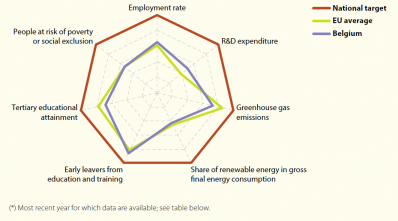Archive:Europe 2020 indicators - Belgium
- Data from December 2014. Most recent data: Further Eurostat information, Main tables.
This article is part of a set of statistical articles based on the Eurostat publication Smarter, greener, more inclusive? - Indicators to support the Europe 2020 strategy. It provides recent statistics on the Europe 2020 strategy of the European Union (EU), focusing on the situation in Belgium.

Source: Eurostat, see dedicated web section: Europe 2020 indicators
Explanations on this radar chart are available here.
Main statistical findings

Source: Eurostat, see dedicated web section: Europe 2020 indicators
Belgium’s employment rate has remained stagnant at about 67 % since the economic crisis began in 2008. Although still at some distance from its national targets, Belgium performed slightly better than the EU average in terms of reducing the rate of early leaving from education and training and increasing R & D intensity. A drop of 1.2 percentage points in the share of the population aged 30 to 34 with tertiary education from 2012 to 2013 has moved Belgium further from its national target. Over the same period the number of people at risk of poverty or social exclusion fell by 3 %, following a steady rise since 2009. Despite the rapid uptake of renewable energy, from 2.3 % of gross final energy consumption in 2005 to 6.8 % in 2012, Belgium still lagged considerably behind its target. The downward trend in GHG emissions in non-ETS sectors in the period 2010 to 2012 brought Belgium closer to its target, although it remained at a larger distance than the EU average.
Data sources and availability
More information about the origin of the data and the calculation of indicators can be obtained via the Europe 2020 indicators dedicated website.
Under 'Tables', click on the icons next to the indicators:
- 'Explanatory texts (metadata)' for a detailed overview of the collection and compilation methods;
- 'Information on the leaf' for data availability per country.
A more general overview of quality procedures can be found in Implementation of standard reference metadata for indicators - the ESMS Indicator Profile (ESMS-IP) (PDF file).
Context
Europe 2020 is the EU’s growth and jobs strategy for the current decade, striving to pave the way to a smart, sustainable and inclusive future. The strategy envisages measures to overcome the economic crisis and move beyond it by addressing the structural weaknesses in the European economic model. The final objective is to deliver high levels of employment, productivity and social cohesion in the Member States, while reducing the impact on the natural environment.
See also
Further Eurostat information
Publications
- Smarter, greener, more inclusive - indicators to support the Europe 2020 strategy (online publication, also downloadable as PDF file)
Main tables
Dedicated section
Methodology / Metadata
- Towards robust quality management for European Statistics - Communication from the Commission COM(2011) 211 final
Other information
- Regulation 223/2009 of 11 March 2009 on European statistics